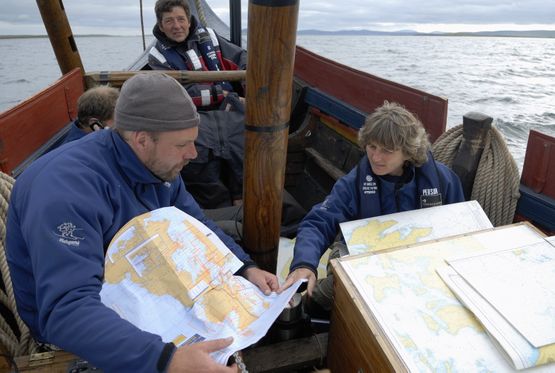
Dead reckoning
When sailing, it is important to know your position at any time.
Sometimes it is possible to make. These can be bearings of known places on land, astronomically observations of sun and stars, or – in modern times – a reading from an electronic navigational instrument. This gives an observed position, which can be plotted on a chart.
Before the age of electronic navigation, a long time could elapse before it was possible to make an observation. Just think if there was dense fog!
As it was crucial to keep a check on how far one had sailed and in which direction since the last observed position. Then it was possible to draw a line from the observed position in the right direction and distance and obtain an estimated position. An estimated position is of course not as reliable as an observed position but it is better than nothing!
This important work in keeping check on course and distance is referred to as dead reckoning. The distance sailed could not be measured directly but it could be calculated by multiplying the ship's speed with the time sailed:
Distance (D) = Speed (V) x Time (T).
This is referred to as dead reckoning. It was therefore important to have both an accurate chronometer and to be able to measure the ship's speed.
Download the exercise sheet Dead reckoning and try for yourself!
Dead reckoning
This exercise works with ordinary multiplication using the formula D=V*t. It deals with topics such as:
- Subtracting two points from each other and converting hours and minutes to decimal hours
- Calculating distance as a product of speed and time
- Plotting angles with a protractor.
- Plotting distances to scale.
When this problem has been solved you can proceed to the next part - to find out your speed. The same formula is used, but now speed is the unknown factor.
You can also discuss how time was measured. Try asking a group to count up to 60 seconds in their heads – some using only numbers, others using "one-crate-of-beer, two-crates-of-beer…." , "one elephant, two elephants…." or a similar enumerations – and see who comes closest to the minute mark.
The exercise sheet Dead reckoning should be printed out and you will also need a pencil, a protractor, and possibly a ruler.
Subject: Maths
Suitable for age: 14 – 20 years.
Read more
Tools
- Dead reckoning EN.pdf
- exercise sheet